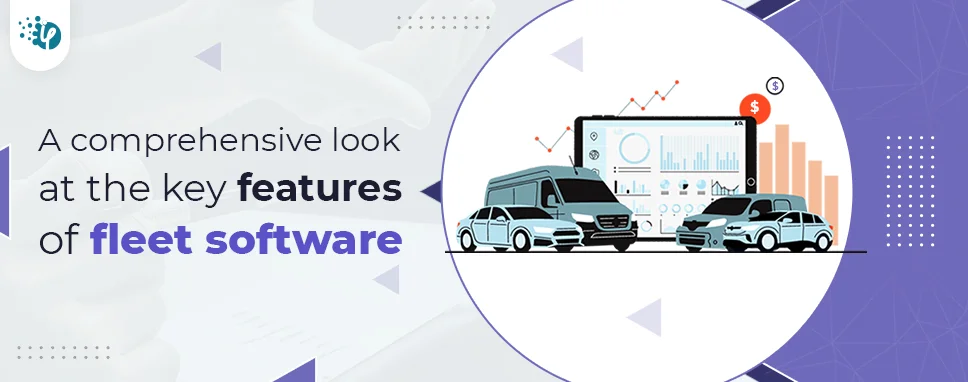"Fleet management software features
Fleet management software is primarily used to ease complicated fleet management difficulties in the logistics, supply chain, and other transportation sectors. There are a few key characteristics in fleet management software that can turn a small fleet into a multimillion-dollar enterprise.
System for fuel management
Fuel consumption is maintained, controlled, and monitored using fleet management software. Fuel management is the primary area in which a fleet manager may exert significant cost control.
Real-time tracking
Real-time tracking is utilized in a variety of businesses that rely on transportation, although it is most commonly used in logistics. Transportation of commodities from point of origin to point of consumption is the basis of logistics. Monitoring fleet movement is a common strategy for saving time, and money, and increasing production. With and without GPS, real-time tracking was carried out. GPS tracker systems are organized in a certain way. A GPS tracking equipment, GPS tracker server, and user interface are all required.
Optimization of the Route
Route optimization is a technique for reducing the amount of fuel, time, and money spent on a journey. Route optimization is a method for running a lucrative fleet management organization. Route optimization uses a specific algorithm to produce the best results. If any modifications occur with the vehicle on the road route, an alert will be raised in the interface application.
Management of vehicles and drivers:
Maintaining vehicle procurement, such as vehicle fitness certificates, insurance, and scheduling vehicle maintenance on a regular basis. A fleet manager cannot manage, maintain, or recall the fleet's maintenance schedules. As a result, fleet management software assists you in maintaining, managing, and remembering all of a vehicle's requirements. When it comes to driver safety, fleet management software keeps track of things like accident management, speed control, procurement management, and managing a driver's driving style, among other things A good fleet management software will give you all the tools you need to run a fleet management company.
Customer service
Yes, customer service should be given high priority. In the process of selling a product, the development and customer support chains are intertwined. It doesn't matter if it's a massive industry or a well-known brand; at the end of the day, it's all about consumer pleasure. The brand's image is based on customer happiness. How can you get a high level of client satisfaction? Provide better customer service and higher-quality items. Customer service is the portion of your website where you can win a customer's heart and grow your business."
"Significant features of the fleet software are -
- Visibility in real-time.
- Capabilities for driver management
- Complete integration and open, scalable software.
- Software for fleet dispatch and planning (including vehicle management)
- Learning by machine.
- Driver retention and performance solutions"
- Della Cloud, work at NWPH
"GPS tracking of vehicles
With these devices, you can track your fleet's location and movement in real-time. Vehicle arrival times can increase productivity and customer satisfaction.
Analyzing driving behavior
Driving behavior analysis modules can detect acceleration, harsh braking, speeding, and overheating. As a result, poor driving habits can be corrected, and accidents avoided.
Fleet alarms
Alarms help fleet operators respond quickly to any difficult situation.
Fuel management
Fuel cost is a significant part of a company's budget, so fleet managers must manage fuel consumption efficiently.
Monitoring and planning routes
When you monitor routes and anticipate future events, you can reduce fuel consumption, increase productivity, and improve fleet management."
- Christian Velitchkov Co-Founder of Twiz LLC
"Fleet management software is an application that looks at the needs of a business and helps it meet those needs. It has many benefits, from keeping you organized to be able to handle unexpected events as they arise. Furthermore, fleet management software can help make your company more profitable by making transportation expenses more manageable and tax-deductible. Here are some of the most important features to know about when you purchase fleet management software:
Organizing your company
Fleet management software can help organize your company so that it lasts longer and has more money in its wallet. Having a system that keeps track of what's being done can help eliminate problems such as employee theft, taxes, and damaged cargo. Some services even allow you to access your vehicle inventory electronically, making it easier to locate a vehicle when needed.
Keeping your company safe
Fleet management software can help keep your company safe from a variety of different things, from employee theft to safety issues. Some programs even offer a system that lets drivers and dispatchers know when a driver has exceeded their driving hours. These systems also allow you to track mileage so that you can claim it as a tax deduction.
Preparing for the unexpected
Businesses occur despite the best plans, and fleet management software can help prepare for these eventualities. For example, some programs provide a way to track your company assets. When there is an accident, you can find the exact value of your assets so that you know what to claim for insurance. Other systems provide an inventory system that can alert you when a vehicle is missing or lost.
Driving behavior analysis
The superior fleet management systems will have a classic feature to measure and assess driving behavior. Its driving behavior analysis module lets you assess acceleration, speeding, harsh braking, and over idling. It will quickly share feedback with the drivers to assist them in correcting poor habits and help prevent mishaps. It will also create a noticeable reduction in fuel charges as drivers are driving more economically.
Fleet alarms
Alarms are the most prominent and valuable feature for organizations to respond to any cumbersome situation concerning their fleets quickly. Therefore, fleet software must allow you to make custom alarms based on your needs, such as it can be set to analyze speeding or the temperature of the heat-delicate merchandise."
"Delivery management systems that help firms manage fleets for best performance, efficiency, and cost are fleet management software. These logistics management solutions should include fleet software for managing your whole fleet of drivers, dispatchers, and vehicles. Here are some of the vital features of it:
Real-time visibility
When companies search for technology to help them better manage their fleets, one of their main goals is to know what's going on and where it's going in real-time. If you want to know where each order is, whether it's with your fleet or with a contractor's driver, you'll require vehicle tracking (or GPS tracking per driver). Some of this visibility comes through fleet tracking, which gives all key stakeholders, including dispatchers or fleet managers (including an external contractor if it's their driver), shippers, and the end customer, visibility into driver whereabouts.
Driver management capabilities
Driver management is having complete control over your drivers to ensure that you fulfill your KPIs and SLAs, that your drivers arrive on time, and that your deliveries go successfully. Calculating profits, scheduling, tracking and understanding performance, and permissions control are all part of this process. It would help if you had comprehensive control over your drivers, whether your fleets are internal or external, to guarantee that deliveries are made on time, that SLAs are satisfied, and that delivery runs smoothly.
Machine learning
You need as much data as possible – on both macro and granular levels – to achieve optimal fleet performance and efficiency. Understanding which fleet delivers faster, for example, might help you select who to deploy – but knowing whether that speed is due to faster time on the road, time on site, or time returning to the base can also be helpful (e.g., a warehouse or store). Look for a fleet management system that can track time to base, time on the side, vehicle unloading time, and other parameters using historical data and machine learning."
- Steven Walker, CEO of Spylix
"Fleet vehicle tracking
Knowing where your assets are on the map in real-time. That is why GPS vehicle monitoring is an essential component of fleet management. With fleet vehicle tracking, you'll always know where your cars are, what route they're on, where they've stopped, and how long they've been there. Imagine what you could accomplish with this information in your hands, for example, the cost-cutting modifications you could make, not to mention all the mishaps you could avoid.
Alerts & Notifications
Alerts are a handy function when you need to react fast to a challenging scenario involving your vehicles and drivers. When you set up your alerts, you'll be notified when something goes wrong, and you'll be able to take action right away to ensure that your vehicles are running efficiently and cost-effectively.
Fuel management
Fuel consumption monitoring and reporting are essential features of a sound fleet management system for controlling and optimizing fuel expenses, particularly those resulting from excessive engine idle, risky driving behaviors, and fuel theft. Thankfully, fleet management systems can provide such reports, including information on every fuel purchase and usage activity.
Vehicle maintenance
Another critical component of a suitable vehicle management system is proactive vehicle maintenance. You can access all the vehicle status and diagnostics data you need with this feature, allowing you to keep everything under control. You'll also be notified of routine checkups and repairs when using this option."





















